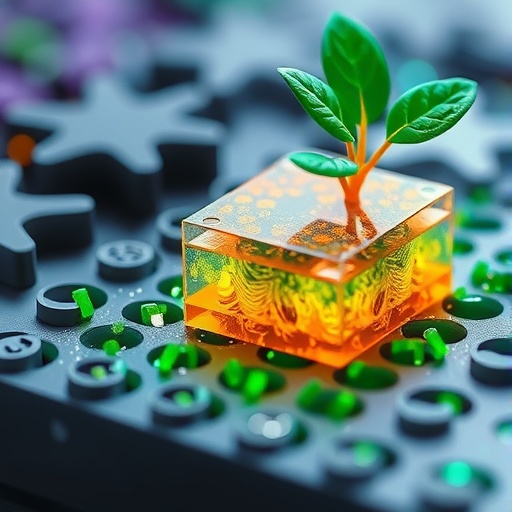In recent years, environmental degradation has emerged as one of the most critical challenges facing the global community, driving scientists to explore innovative solutions to combat pollution and restore ecological balance. One promising avenue is the field of photocatalysis, where researchers harness the power of light to promote chemical reactions that can break down harmful pollutants. A groundbreaking study by Jeyabalan, Mainali, and Kumar is set to revolutionize the understanding of photocatalytic processes, specifically focusing on the synergistic effects of piezo-assisted KNbO₃/BiOCl S-scheme heterojunctions in enhancing the degradation of organic pollutants.
The ability of photocatalysis to convert light energy into chemical energy sparked interest among researchers for its potential applications in wastewater treatment, air purification, and even solar energy conversion. In essence, photocatalysts are substances that facilitate a chemical reaction upon exposure to light, leading to the breakdown of recalcitrant compounds present in various environmental contaminants. However, the efficiency of traditional photocatalytic materials often falls short due to limitations such as rapid recombination of charge carriers and insufficient light absorption.
This is where the innovative S-scheme heterojunction approach comes into play. The authors of the study propose a novel configuration of KNbO₃, a perovskite-type oxide known for its excellent semiconductor properties, and BiOCl, a known photocatalyst with a layered structure. By combining these materials, the researchers aim to create a heterojunction that optimally balances the absorption of light and the movement of charge carriers, thus enhancing photocatalytic efficacy.
Moreover, the integration of piezoelectric effects adds another layer of complexity and improvement to the system. Piezoelectric materials generate electric charges in response to mechanical stress, which can further assist in the effective separation of charge carriers generated during photocatalytic reactions. This mechanical-electrical synergy has the potential to significantly increase the efficiency of the photocatalytic process, making it possible to degrade organic pollutants at unprecedented rates.
In their study, the researchers meticulously detail the synthesis process of the KNbO₃/BiOCl S-scheme heterojunctions. Using advanced techniques such as sol-gel synthesis followed by calcination, the team successfully created uniform and crystalline structures of both KNbO₃ and BiOCl. Comprehensive characterization techniques including X-ray diffraction (XRD), scanning electron microscopy (SEM), and UV-Vis spectroscopy were employed to study the physical and optical properties of the synthesized materials, confirming their effectiveness for photocatalytic applications.
The team conducted rigorous experiments to evaluate the photocatalytic performance of the heterojunction under various light conditions. They observed a remarkable increase in the degradation rates of targeted organic pollutants when subjected to UV and visible light irradiation. The presence of the piezoelectric effect was also tested by applying mechanical stress on the photocatalytic system. The results indicated that this approach further enhanced pollutant degradation, showcasing the influence of piezo-assisted techniques on photocatalytic efficiency.
One of the key highlights of the study is the detailed analysis of the reaction mechanisms involved in the photocatalytic degradation process. The authors employ advanced spectroscopic techniques to investigate the generation of reactive oxygen species, which play a pivotal role in breaking down organic contaminants into non-toxic byproducts. They demonstrate a clear correlation between the photocatalytic activity and the formation of these species, illustrating how the S-scheme heterojunction can be dynamically tuned for optimal performance.
Furthermore, the environmental implications of enhanced photocatalytic degradation are profound. The ability to efficiently break down organic pollutants can significantly reduce the levels of toxic substances in wastewater, thus safeguarding water quality. This has far-reaching consequences for public health and ecological conservation, particularly in regions where contaminated water sources are prevalent.
The study also emphasizes the sustainability aspect of this research. The employed photocatalytic technology not only aims to tackle pollution but also positions itself as a green alternative to conventional chemical treatments, reducing dependency on hazardous reagents while utilizing renewable resources like sunlight. The dual benefits of environmental restoration and sustainable practice make this research a significant leap forward in the fight against pollution.
In conclusion, the innovative work by Jeyabalan, Mainali, and Kumar sets a new benchmark in the realm of photocatalytic research. By harnessing the synergistic combinations of KNbO₃ and BiOCl in S-scheme heterojunctions, along with the application of piezoelectric effects, their study paves the way for next-generation photocatalysts that promise higher efficiency and greater environmental benefits. This research not only contributes to scientific understanding but also offers realistic solutions to one of the most pressing issues of our time: the urgent need for effective pollution control.
As scholars and industries alike look to further this line of inquiry, this study stands out as a beacon of hope and ingenuity, demonstrating how interdisciplinary approaches can yield transformative results in environmental science. Ongoing research following this trail can catalyze the development of even more potent photocatalytic materials, revolutionizing the future of environmental remediation and sustainability.
Subject of Research: Enhancing photocatalytic degradation of organics using piezo-assisted heterojunctions.
Article Title: Enhancing photocatalytic degradation of organics: synergistic insights from piezo-assisted KNbO₃/BiOCl S-scheme heterojunction.
Article References:
Jeyabalan, S.S., Mainali, B. & Kumar, M. Enhancing photocatalytic degradation of organics: synergistic insights from piezo-assisted KNbO3/BiOCl S-scheme heterojunction.
Environ Sci Pollut Res (2025). https://doi.org/10.1007/s11356-025-36956-6
Image Credits: AI Generated
DOI: 10.1007/s11356-025-36956-6
Keywords: photocatalysis, environmental remediation, heterojunctions, piezoelectric effects, organic pollutants.




